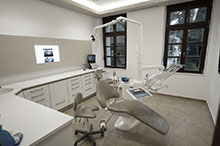Sinus Lift
Maxillary sinus floor augmentation[1] (also termed sinus lift, sinus graft, sinus augmentation or sinus procedure) is a surgical procedure which aims to increase the amount of bone in the posterior maxilla (upper jaw bone), in the area of premolar and molar teeth,[2] by sacrificing some of the volume of the maxillary sinus.
When a natural tooth is lost, whether through dental decay, periodontal disease or dental trauma, the alveolar process begins to remodel. The edentulous (toothless) area is termed a ridge, which over time usually loses both height and width. Furthermore, the level of the floor of the maxillary sinus gradually becomes lower. Overall, this leads to a loss of volume of bone which is available for implantation of dental implants, which rely on osseointegration. The goal of the sinus lift is to graft extra bone into the maxillary sinus, so more bone is available to support a dental implant.[3]
We use one of the following techniques to achieve sinus lift.
- Crestal approach
- Lateral window
Crestal Approach
Lateral Window
The Office

This is a modern dental clinic, with high-end equipment, adapted to the requirements of modern medicine in the dental field.




